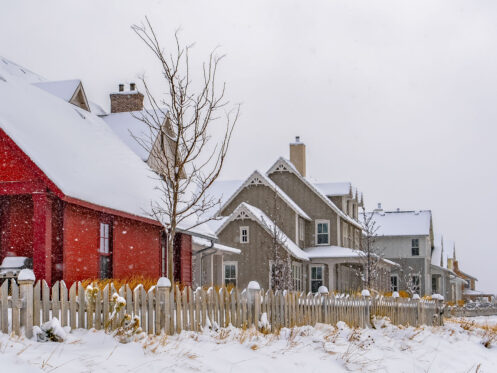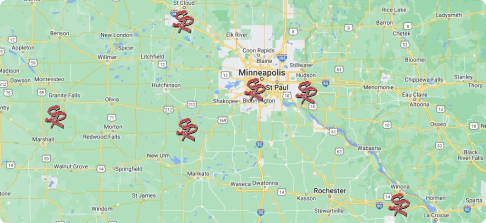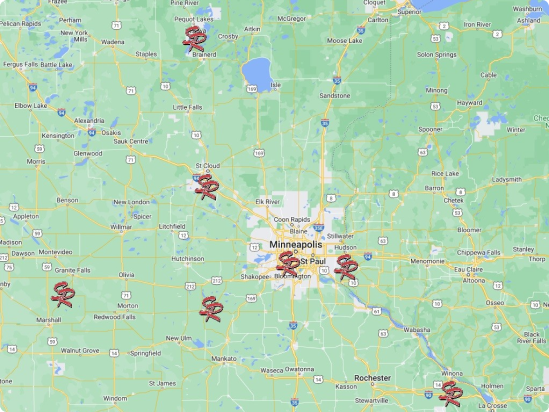Minnesota winters are no joking matter, with an average of 44 inches of snowfall each year. Your roof must be ready to handle all this snow. Consider these 10 easy ways to prepare your roof before the snow starts flying this winter.
1. Check for Missing or Damaged Shingles
Whether you’re preparing for winter or just seasonal rain, the condition of your shingles is important for protecting your home. Start by checking for missing or damaged shingles. Shingles may rip apart during strong winds, especially as the roof ages. This may not look like the underlying roofing deck but will show the part of the shingle under the missing section. If you’re comfortable climbing onto your roof, check for cracked shingles and areas where nails are popping up. Otherwise, call a professional roofer for help. Any damage of this kind should be repaired before it gets cold and snow starts accumulating.
2. Clear Your Gutters and Downspouts
Gutters are integral to helping direct water away from your roof without allowing it to get under your shingles. Your downspouts are equally important to prevent erosion of your foundation.
When you check your gutters, make sure they are still securely attached. Clear out any debris from within the gutter itself. Check for a buildup of shingle granules that may indicate your shingles are wearing out. Confirm that your downspouts are still secured to your home and that the ends are still open, allowing water to flow freely from them.
3. Seal Flashing and Vents
There are key junctions on your roof that are more susceptible to leaks. Most of these areas are either joints in the roof sealed with flashing or air vents with seals. Check the flashing, which is usually metal, to make sure it’s still well sealed. If it appears loose, have it resealed with sealant and possibly flashing tape.
Roof vents usually have shingles that act as a form of flashing around the edges of the vent base. Check that the shingles are still in good condition and lying flat and that the edges of the roof vents are covered. Double-check any pipe vents coming through the roof, and ensure that the rubber boot seal is still good, not cracked or missing rubber. Replace the entire boot if the rubber is damaged and could allow water to seep in.
4. Check the Shingle Granules and Ice Shield
Look at your shingles to see how much of the granule layer has come off. If you can see the fiberglass underneath, you have lost a lot of the protection that shingles normally offer. When this happens, water may seep in where shingles are missing granules and soak the underlayment.
Likewise, it’s important to check the ice shield that’s around all edges of your roof. It’s this layer that helps prevent ice dams over the winter, which can put substantial strain on your roof decking. You must be on the roof, or at least a ladder, to check both the granules and the ice shield, so exercise caution if you decide to check it for yourself. It’s safer to leave this to a professional.
5. Inspect Your Attic Insulation
Your attic insulation may not technically be part of your roof, but it does play an important role in how your roof performs over the winter. Without sufficient insulation, heat will escape through your attic, allowing the shingles to get warm enough to melt the underside of the snow. Unfortunately, the air temperature outside and the temperature of the surface snow create an ideal environment for ice to form on your roof. Even if there isn’t an ice dam, melting snow can get under your shingles and then freeze, loosening the shingles and creating a leak.
6. Reinforce Weak Roof Decking
With a properly functioning roof, the underlying deck should remain strong. However, roof decking is usually made of plywood or oriented strand board (OSB), both of which absorb water. This can compromise the integrity of the decking, allowing parts of it to sag and create areas for water to get under the shingle and develop a leak. If it’s not quite time to replace your roof, you may want to ask a licensed roofer to reinforce the boards from underneath. Keep in mind that this does not undo the damage to the decking boards, so it is only a temporary solution.
7. Consider Adding a Snow Retention System
While kids may like the phenomenon known as a roof avalanche, they can be dangerous and cause property damage. Snow retention systems are sets of bars that run horizontally across your roof and other fixtures to prevent snow from moving past that point until it melts. One of the risks with snow retention is the weight it can add to your roof, so be sure that your roof is rated to handle the weight of accumulating snow. With the wide range of options, it’s best to work with a roofing professional to identify which is best for your home and get it properly installed.
8. Get a Professional Roof Inspection
If you want to get the most from your roof, plan to have it inspected regularly. Experts recommend doing this every one to two years. Generally, as your roof ages, you may want to move to having it inspected annually. A roof inspection generally includes checking for:
- Damaged surface material
- Weaknesses in the roof decking
- Water damage, mold or rodents in the attic
- Effective ventilation
- Block or worn gutters
- Damage to the fascia and soffits
9. Be Ready for Emergency Roof Snow Removal
The building code for residential roof load around Burnsville, MN is 35 pounds per square foot, which equals roughly 28 inches of snow. However, significant snowstorms can dump substantially more, like the storm in January 1994 that dumped 47 inches, which translates to nearly 60 pounds per square foot. This kind of load can cause leaks, sags in the roof, compressed insulation and, in extreme situations, roof collapse. Rather than going into the season unprepared, select an emergency snow removal company in case one of these extreme storms hits this year.
10. Trim Back Overhanging Branches
Finally, it’s important to trim back any overhanging branches from over your roof. If they are touching the roof or low enough to touch it when loaded with snow, they can scrape and scratch the roof. The concern here is damaging the granule coating on the shingles, making them more prone to leaking. Even if the branches aren’t low, they can break when made brittle by the cold, weighed down by snow and then strained by the wind. When these fall, they can damage your roof with impact damage or punctures.
For more than 30 years, Schmidt Roofing has been the roofing company of choice for property owners in Burnsville and the surrounding areas. Our team provides residential and commercial roofing, siding, gutter, window and skylight services along with snow and ice removal.
Call now to schedule a roofing inspection with one of our experienced inspectors!



